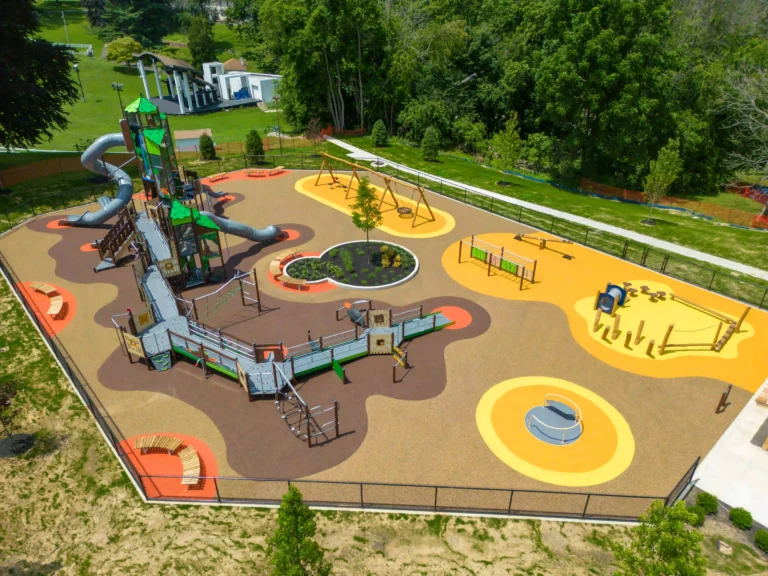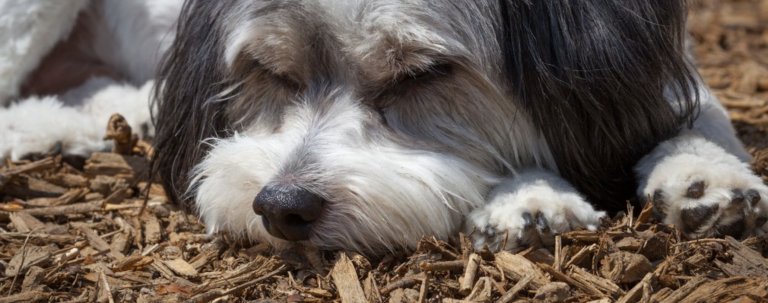Playgrounds are a haven for children, offering them a space to play, learn, and socialize. The flooring of these playgrounds plays a pivotal role in ensuring their safety and enjoyment.
The right flooring can prevent injuries, reduce maintenance costs, and provide an inclusive environment for all children, including those with disabilities.
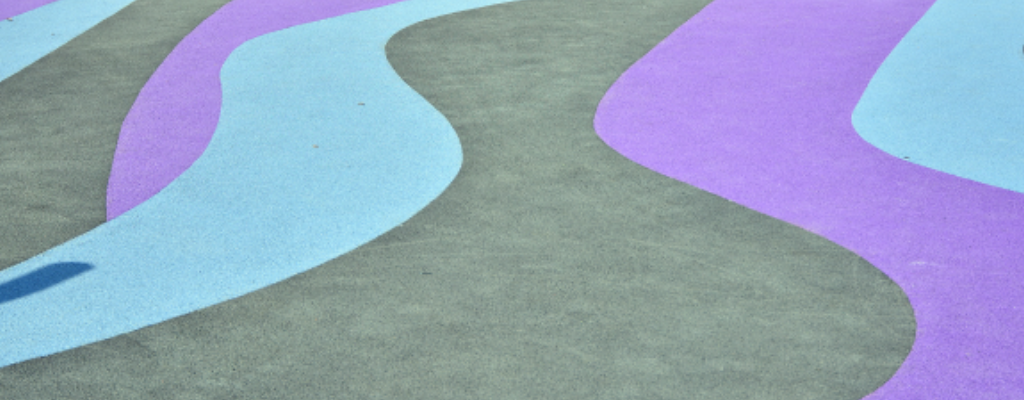
The Benefits and Importance of Rubber Playground Flooring
Safety First
Impact Absorption: One of the primary concerns in playgrounds is the risk of injuries from falls. Rubber flooring, with its inherent shock-absorbing properties, significantly reduces the severity of injuries. The soft and cushioned surface can absorb the impact, ensuring that even if a child falls, the chances of severe injuries are minimized.
Non-slip Surface: Wet playgrounds can become hazardous, with the risk of slips and falls increasing. Rubber flooring, with its natural non-slip properties, ensures that children can play safely even after a rain shower or in areas prone to moisture, like near water fountains or pools.
Durability and Longevity
Rubber is known for its resilience. Unlike other materials that might crack, splinter, or break, rubber stands the test of time. It can withstand heavy foot traffic, the playful antics of children, weather changes, and even the occasional rough play. This durability means that over the long run, rubber flooring often proves to be a cost-effective choice, requiring fewer replacements or repairs.
Environmental and Economic Benefits
Recycled Rubber: Many rubber playground surfaces are made from recycled rubber, primarily old tires. This not only reduces the environmental footprint but also ensures that
non-biodegradable waste is given a second life in the form of safe playground surfaces.
Cost-Effective in the Long Run: While the initial investment might be higher than some other materials, the long lifespan and reduced maintenance needs of rubber flooring often result in significant savings over time.
Aesthetic Appeal and Design Flexibility
Vibrant Play Areas: Rubber flooring is available in a plethora of colors and designs. This allows playground operators and designers to get creative, crafting vibrant, engaging, and themed play areas that can stimulate children’s imaginations.
Customization: Whether it’s incorporating school logos, creating game patterns like hopscotch, or designing specific zones for different age groups, rubber flooring offers unparalleled customization options.
Inclusivity and Accessibility
Rubber playground flooring is not just about fun and safety; it’s also about inclusivity. Its smooth, even surface is ideal for children with mobility challenges or those using wheelchairs. By choosing rubber flooring, playground operators send a clear message: every child, irrespective of their abilities, is welcome and valued.
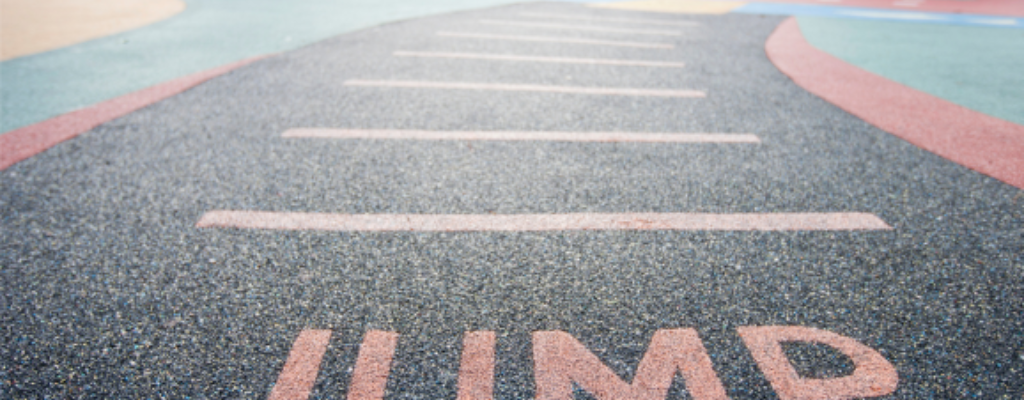
Types of Rubber Playground Surfaces
Poured in Place Rubber (PIP)
Poured in Place Rubber, often abbreviated as PIP, is a popular choice for many playgrounds due to its seamless nature. This type of flooring is created by mixing rubber granules with a binding agent directly on the site, allowing it to be molded and shaped as per the playground’s design. One of the standout features of PIP is its ability to incorporate custom designs, patterns, and even logos directly into the surface. This customization makes it ideal for themed playgrounds or those looking to create specific play zones. While PIP offers a durable and wheelchair-accessible surface, it does come with a higher initial cost and typically requires professional installation to ensure longevity and performance.
Rubber Tiles (TIL)
Rubber tiles are pre-manufactured square or rectangular pieces that are pieced together to cover the playground surface. These tiles are especially favored for their ease of installation and the ability to replace individual tiles if they become damaged. This modular nature ensures that maintenance costs remain low over time. However, it’s essential to ensure that the tiles are correctly installed to prevent them from becoming dislodged, which could pose a tripping hazard.
Engineered Wood Fiber (EWF)
While not rubber, Engineered Wood Fiber is worth mentioning as it’s a common choice for playground surfaces. EWF consists of wood chips that have been specifically designed for playground use. They offer a natural aesthetic appeal and are often more cost-effective than other options. However, EWF surfaces require consistent maintenance to ensure they remain level and free from potential hazards. Over time, areas under swings or at the base of slides can become compacted or worn away, necessitating regular top-ups.
Hybrid Surface Systems (HYB)
Hybrid systems combine the benefits of multiple materials to create a versatile playground surface. For instance, a playground might use PIP in high-traffic areas while incorporating rubber tiles in others. Another example is combining rubber with artificial turf to create varied textures and play zones. These systems can be tailored to the specific needs and budgets of a playground, offering a balance between performance, aesthetics, and cost. However, they might require specialized maintenance given the mix of materials.
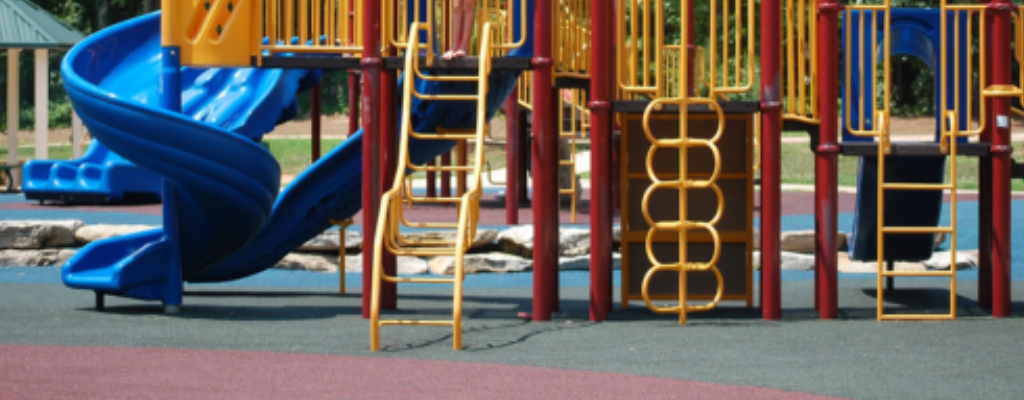
Installation and Maintenance of Rubber Playground Surfaces
Installation
Ground Preparation: Before any rubber material is laid down, it’s essential to prepare the ground. This involves removing any debris, leveling the area, and ensuring proper drainage. Depending on the location, a geotextile fabric might be placed down to prevent weed growth and to stabilize the ground.
Sub-base Construction: Especially for poured in place rubber, a sub-base, often made of compacted stone, is required. This provides a stable foundation and ensures proper drainage. The thickness of the sub-base can vary based on the type of rubber flooring and the specific needs of the playground.
Mixing and Pouring (for PIP): Once the base is ready, the rubber granules are mixed with a binding agent. This mixture is then poured onto the playground surface and troweled out to ensure an even thickness. It’s crucial to mix the right proportions to ensure the durability and longevity of the surface.
Tile Placement (for Rubber Tiles): If using tiles, they are laid out from one corner of the playground, ensuring that they fit snugly together. Some tiles come with interlocking mechanisms, while others might require adhesive.
Maintenance
Routine Inspections: Regular checks are crucial to identify potential issues early on. Look for signs of wear, loose tiles, or areas where the rubber might be thinning.
Cleaning: Over time, the surface can accumulate dirt, leaves, and other debris. Regular sweeping or blowing can keep the area clean. For deeper cleaning, a mild detergent and water can be used, followed by a thorough rinse.
Repairs: One of the benefits of rubber surfaces is that minor damages can often be repaired without replacing the entire surface. For PIP, a mixture of rubber granules and binder can patch small areas. For tiles, individual damaged tiles can be replaced.
Replenishing Engineered Wood Fiber (EWF): If using EWF, it will compact over time, especially in high-traffic areas. Regularly adding more EWF can ensure the surface remains at a safe depth.
Sealing and Protecting: To prolong the life of the rubber surface and maintain its vibrant color, consider applying a sealant or protective coating. This can offer added protection against UV rays, heavy usage, and other environmental factors.
Accessibility Maintenance: For playgrounds aiming to be ADA compliant, it’s essential to ensure that the rubber surface remains smooth and accessible. This might involve regular checks to ensure wheelchair accessibility and that there are no tripping hazards.
Conclusion
Playgrounds are more than just spaces for children to expend energy; they’re crucial environments for growth, learning, and social interaction. The choice of flooring plays a pivotal role in shaping these experiences. Rubber playground flooring, with its myriad of benefits, stands out as an exemplary choice. It prioritizes safety without compromising on durability, aesthetics, or inclusivity. By investing in such flooring, we’re not just creating a playground; we’re crafting a haven where every child, regardless of their abilities, can play, dream, and discover. As we reflect on the importance of playgrounds in childhood memories, let’s ensure that those memories are filled with joy, laughter, and above all, safety. Rubber playground flooring is more than a surface; it’s a commitment to the future – our children.
For more insights, resources, and to explore our range of rubber playground flooring options, visit our website. Let’s work together to create play spaces that resonate with safety, fun, and inclusivity.

